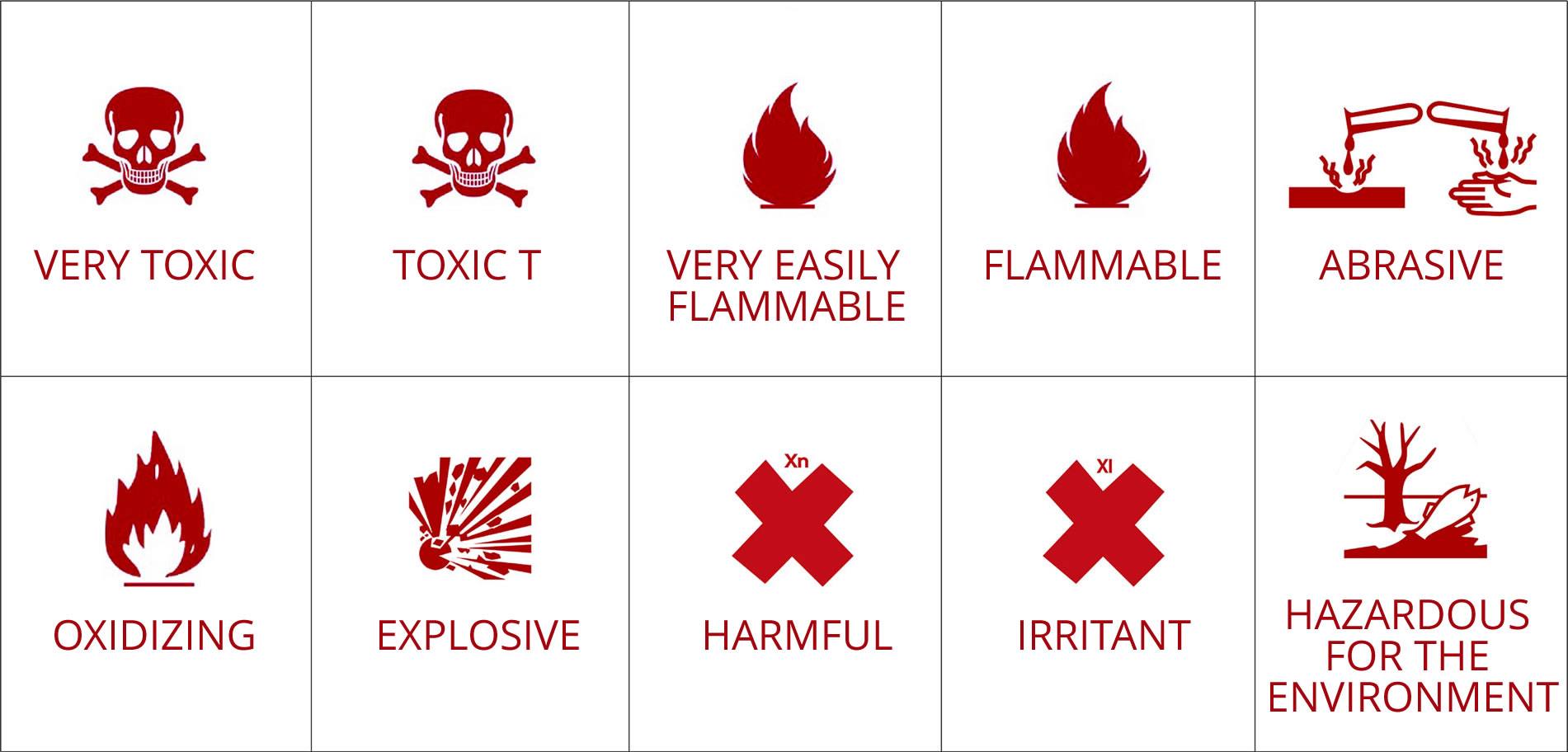Hazardous Chemical Symbols

In the realm of industrial safety and environmental protection, the recognition and understanding of hazardous chemical symbols play a crucial role. These symbols, often universally recognized, provide critical information about the potential risks associated with various substances, ensuring the safety of workers, researchers, and the general public. This article aims to delve into the significance, history, and application of hazardous chemical symbols, offering a comprehensive guide to this essential aspect of safety protocol.
Understanding Hazardous Chemical Symbols: An Overview

Hazardous chemical symbols, a subset of the broader field of chemical safety, are graphical representations designed to convey the nature and severity of the hazards posed by specific chemicals. These symbols, often in the form of pictograms or icons, are an essential component of the hazard communication system, providing a universal language that transcends linguistic barriers. By using these symbols, manufacturers, distributors, and users can communicate the potential dangers of chemicals, facilitating safer handling, storage, and disposal practices.
The development and standardization of hazardous chemical symbols have been a collaborative effort by international bodies such as the United Nations and the International Organization for Standardization (ISO). These organizations have established a comprehensive set of symbols, known as the Globally Harmonized System of Classification and Labelling of Chemicals (GHS), which provides a consistent framework for hazard communication worldwide.
The Evolution of Hazardous Chemical Symbols

The history of hazardous chemical symbols dates back to the early 20th century, when the need for standardized safety measures in industrial settings became apparent. Initially, these symbols were simple and often lacked uniformity, with different countries and industries adopting their own systems. However, the increasing globalization of trade and the rise of international chemical regulations led to a push for standardization.
In the 1960s and 1970s, the concept of hazard pictograms began to gain traction, with organizations like the American National Standards Institute (ANSI) and the European Committee for Standardization (CEN) playing pivotal roles in their development. These early efforts laid the foundation for the GHS, which was adopted in 2003 by the United Nations. The GHS, with its nine standardized hazard pictograms, has since become the global standard for hazardous chemical communication.
The GHS Pictogram System: A Comprehensive Guide
The GHS pictogram system consists of nine distinct symbols, each representing a specific type of hazard. These symbols, which are easily recognizable and color-coded for quick identification, provide critical information at a glance.
| Pictogram | Hazard Type |
|---|---|
 |
Flammable |
 |
Explosive |
 |
Gas Under Pressure |
 |
Corrosive |
 |
Toxic |
 |
Irritant |
 |
Health Hazard |
 |
Environmental Hazard |
 |
Acute Toxicity |

Each pictogram is accompanied by a detailed description of the hazard it represents, ensuring a clear and consistent understanding of the risks involved. For instance, the skull and crossbones pictogram, universally recognized as a symbol of toxicity, warns of substances that can cause severe health issues, including death, upon exposure.
The Flammable Pictogram: A Case Study
Let’s delve deeper into the significance of one of these pictograms: the flame pictogram, which signifies the presence of flammable substances. Flammable materials, often liquids or gases, pose a significant risk of fire or explosion, especially in industrial settings. The flame pictogram, with its vivid red and yellow colors, serves as a stark reminder of this danger.
Consider the case of a manufacturing facility that produces and stores large quantities of flammable solvents. The presence of the flame pictogram on these substances' labels and packaging serves as a constant reminder to workers of the need for extra caution. This includes proper ventilation, the use of appropriate personal protective equipment (PPE), and the strict adherence to fire safety protocols.
The Application of Hazardous Chemical Symbols in Real-World Scenarios
Hazardous chemical symbols are not just theoretical constructs; they are integral to the daily operations of numerous industries, from manufacturing and healthcare to research and environmental management. Let’s explore some real-world applications to understand their practical significance.
Chemical Manufacturing and Distribution
In the chemical industry, the proper use of hazardous chemical symbols is a matter of utmost importance. Manufacturers are responsible for ensuring that their products are correctly labeled, with the appropriate symbols clearly displayed. This not only ensures compliance with legal regulations but also protects workers and customers.
For instance, consider a chemical distributor that supplies various substances to laboratories and industrial clients. By accurately labeling containers with the relevant hazard pictograms, they provide essential information to their customers, allowing them to handle and store these chemicals safely. This simple yet effective measure can prevent accidents, reduce liability, and foster a culture of safety.
Healthcare and Pharmaceuticals
In healthcare settings, the safe handling and administration of medications is critical. Hazardous chemical symbols play a vital role in ensuring that healthcare professionals are aware of the potential risks associated with different drugs. This is particularly important for substances like chemotherapeutic agents, which are highly effective in treating cancer but also pose significant health risks if mishandled.
Pharmaceutical companies, therefore, employ rigorous labeling practices, ensuring that the appropriate hazard symbols are prominently displayed on medication packaging. This not only informs healthcare workers but also empowers patients to understand the potential risks and take necessary precautions.
Environmental Management and Waste Disposal
The safe disposal of hazardous waste is a complex and critical process, and hazardous chemical symbols play a pivotal role in this domain. Environmental managers and waste disposal experts rely on these symbols to identify and handle waste appropriately, minimizing environmental impact and ensuring public safety.
For example, the environmental hazard pictogram, often depicted as a pictogram of a tree and a fish, warns of substances that can cause ecological damage. This could include chemicals that are harmful to aquatic life or that have the potential to contaminate soil and groundwater. By recognizing this symbol, waste disposal professionals can take the necessary precautions, such as ensuring proper containment and treatment before disposal.
The Future of Hazardous Chemical Symbolization

As our understanding of chemical hazards evolves and new substances are discovered, the field of hazardous chemical symbolization continues to adapt and grow. International bodies like the United Nations and ISO regularly review and update the GHS, ensuring that it remains relevant and effective in the face of emerging challenges.
Furthermore, advancements in technology and data science are providing new opportunities for the application of hazardous chemical symbols. For instance, mobile applications and digital platforms can now provide detailed information about chemical hazards, allowing users to quickly access the relevant pictograms and descriptions.
The future of hazardous chemical symbolization also lies in education and awareness. By integrating these symbols into educational curricula and public awareness campaigns, we can foster a culture of safety and environmental responsibility. This will not only reduce accidents and environmental damage but also empower individuals to make informed decisions about the chemicals they encounter in their daily lives.
What are the key benefits of using hazardous chemical symbols?
+Hazardous chemical symbols offer a universal, visually-oriented method of hazard communication, ensuring that critical information is conveyed effectively, even in multilingual or high-risk environments. They provide a quick, at-a-glance assessment of the potential dangers associated with a substance, allowing for prompt and appropriate action.
How are hazardous chemical symbols regulated and standardized?
+The Globally Harmonized System of Classification and Labelling of Chemicals (GHS) is the primary international standard for hazardous chemical symbols. Developed by the United Nations, the GHS provides a comprehensive set of standardized pictograms, ensuring consistency and clarity in hazard communication worldwide. National and regional regulations often adopt or adapt these standards to suit local contexts.
Are there any challenges or limitations to the use of hazardous chemical symbols?
+While hazardous chemical symbols are a powerful tool for hazard communication, they are not without limitations. One challenge is the potential for misinterpretation, particularly among individuals with limited education or language barriers. Additionally, the GHS system may not cover all possible hazards, and new substances may require the development of additional symbols over time.



